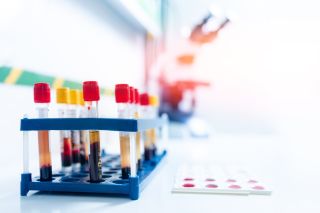Artificial Intelligence
AI Finds Potential Biomarkers in Neurodegenerative Diseases
A recent study using AI spots a gene expression common in Alzheimer’s.
Posted January 6, 2023 Reviewed by Tyler Woods
Key points
- A new study demonstrated that six neurodegenerative diseases share common dysfunctions in fundamental cellular processes.
- The researchers used an AI machine learning algorithm to analyze and derive classifiers for the maladies.
- The combination of AI and neuroscience may be the first step towards developing diagnostics for a wide range of diseases that impact the brain.

The ability for artificial intelligence (AI) machine learning to find patterns in large amounts of complex data offers great promise for diagnostics for neurodegenerative diseases. A new study published in the journal of the Alzheimer’s Association, Alzheimer’s & Dementia, demonstrated that six neurodegenerative diseases share common dysfunctions in fundamental cellular processes. The study used artificial intelligence machine learning to analyze blood non-invasively.
“The investigation of blood biomarkers for neurodegenerative diseases, coupled with powerful statistical methods using artificial intelligence, has opened a new window on these serious afflictions,” according to a statement from Arizona State University (ASU). “Blood can be easily sampled in living patients at all stages of health and disease, providing a powerful new tool for early diagnosis.”
Arizona State University research scientists Carol Huseby, Elaine Delvaux, Danielle Brokaw, and Paul Coleman focused on six neurodegenerative diseases for this study: Alzheimer’s disease (AD), Parkinson’s disease (PD), Huntington’s disease (HD), Amyotrophic lateral sclerosis (ALS), frontotemporal dementia (FTD), and Freidreich’s ataxia (FRDA).
The researchers used an AI machine learning algorithm called random forest (RF) to analyze and derive classifiers for the neurodegenerative diseases. Random Forest machine learning algorithms do not require a normal distribution and are capable of classifying a large number of features. It is a widely-used AI machine learning algorithm for classification and regression that uses a supervised learning technique consisting of individual decision trees. "Supervised learning" refers to the AI machine learning method of using training datasets that are labeled, thus allowing the computer algorithm to learn from examples where the correct answer is known and has an output label. Random Forest algorithms are based on ensemble learning, where several classifiers, an ensemble of independent models, are used to compute a complex problem.
The AI algorithm put together sets of RNA transcripts that best classified each disease by going through thousands of genes and comparing them with RNA samples from the blood of healthy patients. A transcript is an mRNA, messenger ribonucleic acid (RNA), related to a specific gene. RNA is responsible for a wide range of cell functions and plays a critical role in the production of proteins through a process called protein synthesis.
Errors in the production or sequence of RNA components have been linked to a wide range of diseases, hence for this study, data from mRNA was used. The researchers used data from a large public microarray whole blood mRNA expression dataset called the Gene Expression Omnibus (GEO) repository.
Gene expression is the process of converting the information encoded in a gene in order to make proteins the cell needs in response to internal and external changes. During the first phase of protein synthesis, called transcription, the gene is expressed. The double strands of the DNA helix are unzipped and the genetic instructions in the DNA are copied into a single strand of RNA via the mRNA. The copying of the DNA can also be called transcribing, hence the name transcription.
Next, the mRNA transports the genetic data from the DNA to the ribosome, an organelle of the cell where translation occurs. Transfer RNA (tRNA) delivers the building blocks of proteins, called amino acids, to the ribosome. The tRNA translates the mRNA codon sequence into a growing chain of amino acids that will become a protein. A codon is a sequence of three consecutive DNA or RNA nucleotides that corresponds with a specific amino acid or stop signal during protein synthesis.
“These data indicate that multiple neurodegenerative mechanisms converge upon common fundamental processes that come about by differing transcriptional changes,” wrote the scientists.
Through this innovative approach of using AI machine learning to analyze whole blood RNA transcriptomes, the researchers were able to classify eight types of molecular processes that are common to the neurodegenerative diseases studied.
“Using our novel machine learning algorithm, we found for each disease optimally selected transcripts that classify disease and healthy controls,” the researchers wrote.
These classes include the biological cell functions of protein synthesis, immune processes, transcription regulation, mitochondria/metabolism, cytoskeleton, degranulation, ubiquitin/proteasome degradation, and apoptosis/necrosis.
In addition to AI identifying sets of RNA transcripts that show the common cell dysfunctions across the neurodegenerative diseases studied, it also discovered uncommon transcripts for each disease which may have the potential to be a disease biomarker for diagnostic purposes.
“Screening of whole blood and examination of the complete RNA profile can overcome the limitations of many other forms of testing, which are often less comprehensive as well as expensive, highly invasive and labor intensive,” ASU reported. “Diagnosis through whole blood, in contrast, can be carried out at low cost virtually anywhere in the world. Blood results can be tracked over time, providing a valuable window on disease progression. Research of this kind may also encourage new modes of treatment.”
This proof-of-concept suggests that the transcriptional changes that are common across multiple diseases may provide early clues of what might later develop into specific brain diseases. The combination of AI and neuroscience may be the first step towards developing non-invasive early diagnostics for a wide range of diseases that impact the brain.
Copyright © 2023 Cami Rosso All rights reserved.




